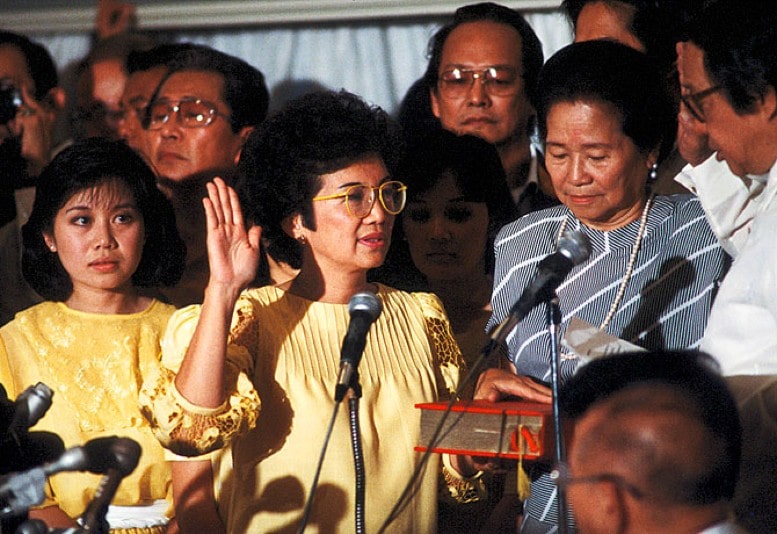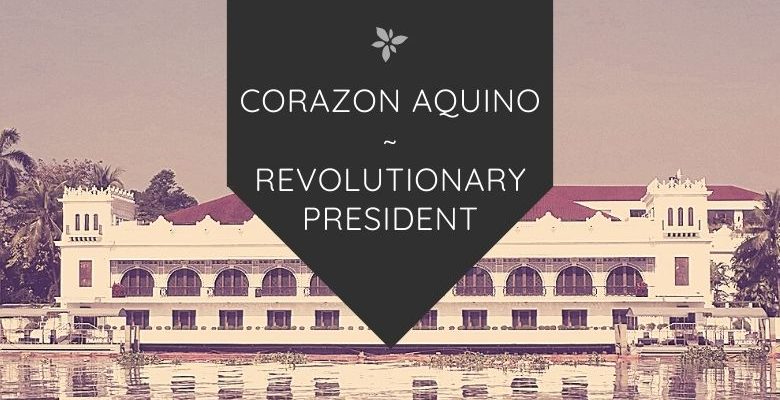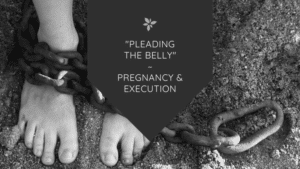Corazon Aquino (1933-2009) was the first female president of the Phillipines, and is known for leading the People Power Revolution in 1986 which restored democracy to the country. She was named TIME’s Woman of the Year in 1986.

Cory Aquino did not aspire to be a politician. In 1955, after graduating from Mount St. Vincent College in New York City, she married Benigno Aquino (nicknamed “Ninoy”), a young politician. She supported her husband’s career as he was elected senator, raising 5 children at home.
Ninoy Aquino became a popular, outspoken opponent of Ferdinand Marcos, the dictator who held the presidency from 1965. In 1972, Ninoy was imprisoned for eight long years, and then exiled to the United States. Ninoy was finally allowed to return to his homeland in 1983, only to be assassinated the moment he arrived.
Ninoy’s imprisonment, exile, and assassination outraged the people and spurred Ferdinand’s opposition. The economic problems of the country deteriorated even further, and the government went further into debt.
After her husband’s assassination, Cory took his place as the leader of the opposition. In 1985, Ferdinand suddenly announced an election to legitimize his hold on the country. Cory was reluctant to run at first, but changed her mind after being presented with one million signatures urging her to run for president.
During Cory’s run for president, Ferdinand Marcos derided her with sexist statements, saying she was “just a woman” whose place was in the bedroom.
Cory just answered: “May the better woman win in this election.”
He also attacked her inexperience in politics. Cory responded by admitting she had “no experience in cheating, lying to the public, stealing government money, and killing political opponents.”
After the elections were held in February 1986, Marcos was declared the winner. There were numerous reports of election fraud, and the outcome was condemned by Catholic Bishops’ Conference of the Philippines and the United States Senate. Ronald Reagan called the the fraud reports “disturbing” in an official statement.
Cory immediately called for peaceful civil disobedience protests, and for organized strikes and mass boycotts of the media and businesses owned by Marcos. Filipinos were enthusiastic in their support. These popular, peaceful demonstrations came to be known as the People Power Revolution. Though Marcos ordered troops against the thousands of protesters (including whole families and nuns and priests), not a shot was fired and the troops withdrew and many defected.
By the end of February, Ferdinand Marcos withdrew from power, fleeing to Hawaii, and Cory Aquino became the President of the Philippines.

Cory’s ascension to the office of president signaled a new era for Filipinos. During the first few months of her presidency, the Philippines experienced radical changes and reforms. Cory immediately created a Constitutional Commission in charge of drafting a new constitution, and created the Presidential Commission on Good Government which went after Marcos’s ill-gotten wealth.
The new Corazon Aquino Administration gave strong emphasis and concern for civil liberties and human rights, and peace talks with communist insurgents and Muslim secessionists. Cory also focused on bringing back economic health and confidence. The Aquino administration succeeded in paying off $4 billion of the country’s outstanding debts.
Cory was also a lifelong member of the Council of Women World Leaders, an international organization of former and current female heads of state and government that helps to mobilize women world leaders to take action on issues critical to the leadership, empowerment and development of women.
In 1992, President Aquino strongly declined the requests for her to seek reelection. She wanted to set an example to both citizens and politicians, in contrast to Ferdinand Marcos, that the presidency is not a lifetime position. She still remained active in the public eye, however, often voicing her views and opinions on the pressing political issues.
Cory Aquino passed away in 2009 of cancer. Her death elicited a worldwide reaction, and thousands attended her wake and funeral. Filipino Catholics called on the Church to have Aquino canonized and declared as a saint.
Hillary Clinton said that Aquino was “admired by the world for her extraordinary courage” in leading the fight against dictatorship. Pope Benedict XVI applauded her “courageous commitment to the freedom of the Filipino people, her firm rejection of violence and intolerance”
Cory was an amazing woman who had a huge impact on the freedom and welfare of millions of people. She accomplished so much in her life and was beloved by many people.
Next, read about Queen Anna of Denmark, Theater Pioneer & Patron of the Arts, or Vigdis Finnbogadóttir: The World’s First Female President.
Keri is a blogger and digital marketing professional who founded Amazing Women In History in 2011.





The second image is not Cory. That’s actress turned politician Vilma Santos being interviewed during Cory’s wake.
Thank you so much for the correction!!! I’ve removed the image from the post. Much appreciated.
Hiya Keri,
I’m a Filipino American teen student, and I noticed you tagged “Latinas” for the post about Corazon Aquino. I just did a report on her and Qiu Jin (both on the background image on this blog, which I appreciate immensely, as women do need to be more represented in our world history) and I wanted to see what you had to say about the Philippines’s first female president and the woman who restored democracy to the Philippines after Ferdinand Marcos. I have great nationalistic pride and affinity in and with this woman leader and her revolutionary presidency both as an introduction to democracy post dictatorship and as a female politician. You can see how I could be disappointed in your tagging “Latinas”. I don’t think we (Filipino women) deserve to be profiled as hispanic or anything but Southeast Asian. I find that though the Philippines was colonized by the Spanish hundreds of years ago, we are our own nation, separate from any affiliation with Spain. I don’t identify as Latina or Hispanic, the Philippines’s national language is Tagalog, and not Spanish. When I’m forced to check my ethnic and racial background into a box on standardized testing, I find myself forced to choose Asian, as we don’t have any affiliation with Latina or Hispanic or Spanish or anything like that. I am constantly confused to be Latina due to the color of my skin (because how dare any Asian identify as anything other than East Asian) and due to the lack of talk regarding Southeast Asian identity. Of course there’s representation of East Asians, South Asians, and Middle Eastern identifying people, but there is an appalling lack of representation of Cambodian, Filipino, and Malaysian or otherwise identifying Southeast Asian subgroups. Your tag, however small and insignificant, did make me personally feel a little sad. Once again, a wonderful Pinay woman has been racially profiled Latina. Not only are you appropriating Latina for someone who does not identify with Latina, but you’re also marginalizing my culture. And I don’t really appreciate that. I mean yeah, you tagged “Filipino women”, and that’s all good, but the Philippines does not identify with Hispanic or Latino/Latina. We are proudly Pinoy/Pinay, and that’s a better tag for this than Latina.
I hope you don’t think I’m mad in any way, I love this blog and I love your drive to make sure that the story of women makes it into history. I think the cause (education about the women who changed and shaped the world but are rarely talked about) is beautiful and should be applauded.
I just think that the use of “latinas” isn’t appropriate use for a Filipina/Pinay woman, and to call her latina would just further bring in that racial profiling of Filipinos as hispanic, and that’s something that I have to face a lot, as someone who looks vaguely Spanish/Japanese mixed race (which I’m super duper not). Latina is something I’ve been called, I’ve had people invite me to Hispanic affinity groups. Despite a lot of Filipino names sounding Hispanic, we are not. Really honestly not affiliated or identifying with that.
Thanks for reading this loooooong critique of your misunderstood hashtag,
– Adrianna, 10th grader.
PS: Sorry for the ramblyness.
One of the biggest urban legends of recent times in the Philippines, is the story that the Cory Administration was supposedly the “cleanest” among the Administrations in the last three decades. Thanks to Nostalgia, and the fact that her Administration was at the dawn of the internet age, much of the negativities of that Administration has been largely forgotten, and people tend to remember only the “good” things about that Administration.
Well, thanks to Noynoy Aquino’s “holier-than-thou” campaign strategy, much of the “unpleasantries” during Cory’s time are being brought back to the surface slowly, but surely. Here are some that I have managed to dig out:
‘Philippine Air Lines Stocks to Nephews’Cory approved in January 1992 the sale of 67% of the stocks of the Philippine Air Lines (PAL) to an investment group headed by her relatives, one of her Tanjuatco nephews, and three of her Cojuangco nephews. The sale resulted in a loss of USD 300-million plus for the Filipino people. The Philippine government, through the Government Service Insurance System (GSIS), owned the shares. And worse, her nephews did not have the money to pay for the airline stocks. They borrowed the money that they used to pay the GSIS from three Philippine government-owned banks, even using the PAL stocks as collateral.
‘Philippine Air Lines Building Scandal’“The PAL Scandal,” where Cory authorized in 1992 the sale of the PAL Building in San Francisco, California. It resulted, according to the column of the late journalist Louie Beltran, into a USD 6-million loss to the national airline. Cory did not charge Mr. Beltran with libel on this issue about the PAL Building. She, however did file a libel case against Mr. Beltran and his publisher, Maximo V. Soliven on a separate issue, when Beltran wrote that Mrs. Aquino “hid under her bed during a coup d’etat attempt at the presidential palace in Manila.”
‘Bargain Sale of Companies to Lopa’The assets of the Marcoses, the Romualdezes and their cronies were supposed to have been sequestered by the new Aquino administration, but Kokoy Romualdez’s (Ferdinand Marcos Sr.’s brother in law) 38 companies, which were worth billions of pesos, were not turned over to the Presidential Commission on Good Government. Cory instead during her first months in office, permitted the transfer of these 38 companies to her own brother-in-law, Ricardo “Baby” Lopa. What’s worst, was the fact that all 38 companies were bought back by Lopa during the transfer for the price of only USD 227,000.
‘Philippine Long Distance Company to Nephews’The same case happened with the ownership of the Philippine Long Distance Company. Instead of sequestering the company for the Philippine government as it was then controlled by the Marcos cronies, she returned the billion-dollar company to her Cojuangco nephews. She claimed that her nephews were illegally eased out by Mr. Marcos. The truth was that the Marcos cronies, whether their money were ill-gotten or not, paid the Cojuangcos the prevailing market-stock prices during the sale of equity that happened between them at the time when Marcos was still president.
‘Re-negotiation of Marcos’ Japanese Loans’Cory approved the re-negotiation of the loans that Ferdinand Marcos Jr. obtained from Japan. The administration of Mrs. Aquino agreed that the loans would be paid in Japanese yen, rather than in U.S. currency that former Marcos negotiated. This simple change in currency resulted in a USD 5-billion increase in the loan principal.
‘Refusal to Give Hacienda Luisita to Farmers’Cory publicly promised in 1986 that Hacienda Luisita will be distributed to the farmers. However, in 1987, she issued Presidential Proclamation 131 and Executive Order No. 229 just days before her legislative powers were going to revert back to Congress, to include a provision in the Land Reform program for a “Stock Distribution Option”, which allows landowners to comply with the Land Reform Law without actually giving land to the farmers. Hacienda Luisita of course took this new option, and thus was not redistributed to the farmers.
‘Double Cross of Doy Laurel’Cory had promised to Doy Laurel that she would let him run the government as Prime Minister after Marcos was ousted, as Cory had no experience in politics. However, in March 1986 she issued Presidential Proclamation No. 3 declaring a revolutionary government, and dissolving the 1973 Constitution. This nullified Laurel’s position as Prime Minister as the Parliament was abolished. This prompted Laurel to break ties with the Aquino regime later.
‘Protecting Hacienda Luisita’s Interests’Cory continued to protect Hacienda Luisita, even firing Miriam Defensor Santiago from her post at the Department of Agrarian Reform after she told the press her opinion that Cory should inhibit herself as chair of the Presidential Agrarian Reform Council (PARC), which was tasked to make the final decision on Hacienda Luisita’s application for the “Stock Distribution Option” (see section on‘Refusal to Give Hacienda Luisita to Farmers’ above).
‘Garchitorena Land Scam’In 1988, a foreclosed property of the United Coconut Planters Bank (UCPB) was sold to Sharp International Marketing for P3.8 million. Before the sale was closed, Sharp tried to sell the same property to the government for P56 million. The sale was eventually approved by the Department of Agrarian Reform (DAR), but only after the price was inflated further to P65 million. The financier of the scam was Romeo Santos, an associate of Cory’s brother, Peping Cojuangco. He was also Cory’s campaign manager in Bicol.
Patricia Laurel
Oh my God, what is this blasphemy?
The Marcoses left the Philippines penniless when Corazon Aquino became the president. From the 2nd richest nation in asia in the 1950s, the Marcoses plundered and squandered the Philippine wealth, so much so that it plunged the country in an economic crisis in 1984!
Thank you Patricia Laurel /Rodel for shining the light in truth about the Aquinos. The Aquinos are not to be admired. They accused the Marcos’ from stealing from the Filipinos yet when it came down to taking the power and wealth from the Marcos’, they kept the money amongst themselves and their families. It did not go back to the people or infrastructures. They’re Terrible. What you say is the truth and sadly some people can’t handle the truth because it destroys the narrative of their article on the “angelic, heroic” Cory Aquino.
Do you even know what you are talking abt? I guess not…… Aquinos are the one who stole money from Filipinos and make the country in poverty. Aquino administration is the one who stole money from Filipinos and not the Marcoses. Aquino doesnt even have any projects or anything that Filipinos will be proud of this days to mention, instead everything that they had done to the country sre drugs, corruption and poverty, etc…
Why there is a ghost in the 3rd picture look at the lady behind Cory